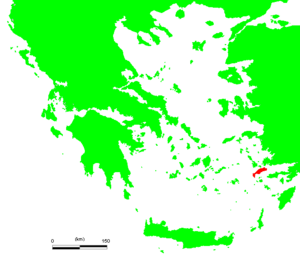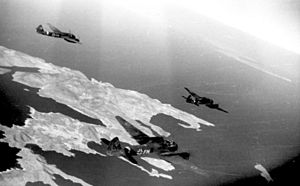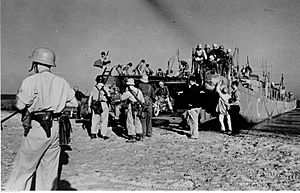Battle of Kos facts for kids
Quick facts for kids Battle of Kos |
|||||||||
|---|---|---|---|---|---|---|---|---|---|
| Part of the Dodecanese Campaign of World War II | |||||||||
 British POWs taken in Kos |
|||||||||
|
|||||||||
| Belligerents | |||||||||
Aviation Support: |
|||||||||
| Commanders and leaders | |||||||||
| Strength | |||||||||
| ca. 3,500 Italians 1,388 British |
4,000 | ||||||||
| Casualties and losses | |||||||||
| 3,145 Italians & 1,388 British POWs 103 Italian officers executed |
15 dead, 70 wounded | ||||||||

The Battle of Kos was a short but important fight during World War II. It happened between British and Italian forces against German forces. The battle was for control of the Greek island of Kos. Kos is in the Dodecanese Islands, located in the Aegean Sea.
The battle started after the Allied powers made a peace agreement with Italy. German forces, with strong air support, quickly took over the island. They defeated both the Italian soldiers and the British troops who had just arrived. This stopped the Allies from using Kos as a base. They had hoped to attack German positions in the Balkans from there.
Contents
Battle of Kos: A World War II Story
In September 1943, Italy surrendered to the Allies. German forces in the Balkans and the Mediterranean moved quickly. They wanted to take control of areas that Italy had held. At the same time, the Allies had a plan. British Prime Minister Winston Churchill wanted to capture the Dodecanese islands.
Why Kos Was Important
The Dodecanese islands had been controlled by Italy since 1912. They were in a very important spot in the southeastern Aegean Sea. Churchill hoped to use these islands as a base. From there, the Allies could attack German positions in the Balkans. He also hoped it would convince neutral Turkey to join the war on the Allied side.
The biggest prize was the island of Rhodes. But German forces quickly captured Rhodes with a strong attack. Still, British forces landed on several other islands. These included Kos and Leros. They joined with the Italian soldiers already there. Everyone hoped they could eventually take back Rhodes.
British Soldiers Arrive
On September 13, 1943, Allied planes bombed airfields on Rhodes. This stopped German planes from flying. Meanwhile, special British units landed on Kos. They took control of the port and the airfield near Antimachia village.
The next day, British and South African planes arrived at the airfield. On the night of September 14-15, 120 paratroopers landed. They were welcomed by the Italian soldiers. The Italians even laid out straw to help them land safely.
More British troops and supplies arrived over the next few days. This included anti-aircraft guns for defense. The Allied force on Kos grew to about 1,600 British troops. About 1,115 of these were combat soldiers. There were also about 3,500 Italian soldiers from the original island defense.
German Air Attacks Begin
The German counter-attack started on September 17. They began with very heavy air bombing. German planes, like Messerschmitt 109s and Junkers 88s, attacked. At first, they faced strong resistance. British anti-aircraft gunners and South African Spitfire planes fought back.
However, special "Butterfly Bombs" made the Antimachia airfield unusable for a while. They also damaged Allied transport planes. Still, the first groups of British soldiers managed to land. One plane crashed into the sea. Its crew was rescued but held in Turkey.
German bombing and machine gun attacks continued for days. The German air force brought more planes to the Aegean area. Their strength grew to 360 aircraft.
Why Air Support Was Limited
While German air power grew, the Allies had few planes. This was because of decisions made by General Eisenhower. He decided that the Dodecanese campaign should not affect other bigger campaigns. This meant the Middle East command could not expect much help. They had to make do with temporary naval and air forces.
Eisenhower's decision was based on the belief that the Dodecanese operation was a distraction. The limited air support for Kos was not enough. This greatly affected the British ability to defend the island. From September 13 to October 3, Allied planes suffered many losses. They were hit by bombs and shot down in air combat.
By September 26, one South African squadron had only four working planes left. British squadrons also arrived but faced constant attacks. The defenders on Kos were in a very difficult situation. The Italian anti-aircraft defense was weak. The British had few resources.
The area around the airfield was too rocky to dig trenches. There was no time to build protective walls. The air attacks were so severe that British paratroopers had to be pulled out on September 25.
Germany Invades Kos
On October 1, 1943, many German ships were seen in ports on Crete. Early the next morning, a German convoy was spotted at sea. Urgent supplies were flown to Kos by five transport planes. While these supplies were being unloaded, news came. A small German invasion fleet of 10 ships was on its way.
The "Polar Bear" Plan
This German fleet carried a special attack force. It included soldiers from the 22nd Infantry Division in Crete. It also had special forces from the mainland called "Brandenburgers." All these forces were led by Lieutenant General Friedrich-Wilhelm Müller.
At 4:30 AM on October 3, the invasion of Kos began. By midday, 1,200 German soldiers were ashore. They had light artillery and armored cars. Dive-bombing by German planes made defending even harder. In the afternoon, Antimachia was taken over.
The main German convoy had seven transport ships and seven landing craft. It also had three destroyers and many smaller boats. The main landings happened at Marmari and Tingachi in the north. Other landings were at Camare Bay in the southwest. Smaller landings took place elsewhere on the island.
German paratroopers also landed west and south of Antimachia. By noon, 1,500 Germans were reported to have landed. Later, more German paratroopers landed in the center of the island. More troops also arrived by sea.
For the British forces, the situation was confusing. By 6:00 PM, it was critical. The British soldiers fought bravely. But they faced more German soldiers and heavier equipment. They had to retreat to positions near Kos town and the airfield. That evening, the Germans attacked strongly. The British were pushed back to a small area around Kos town. By the evening of October 3, German strength was estimated at 4,000 men.
British RAF Regiment personnel used up all their ammunition. They then destroyed their guns. They joined the Durham Light Infantry in defense. When the Durham Light Infantry was pushed back, they also retreated to the hills.
The Italian and British forces stopped fighting in an organized way by 6:00 AM on October 4. About 1,388 British and 3,145 Italian soldiers were taken prisoner. The captured Italian commander, Colonel Felice Leggio, and nearly 100 of his officers were killed by the Germans. This was a major war crime. Some British soldiers escaped to nearby islands. They were rescued by the Special Boat Service at night. The last British soldiers surrendered on the morning of October 8.
What Happened After the Battle
The capture of Kos had very bad results for British operations. Without air support, the Allies could not hold the other islands. The Germans used their advantage. They captured Leros a month later. By the end of November, they had taken over all the Dodecanese islands.
An official report about these operations said: "We failed because we could not set up airfields where we were fighting. The enemy's control of the air allowed them to limit our operations. It made it harder for our land, sea, and air forces. By choosing their time, they could use their smaller forces to win important battles."
The report also added: "If we had more aircraft, especially modern long-range fighters, and more luck, the operations might have lasted longer. But after losing Kos, it's doubtful Leros could have been held. This would have needed a major operation, and we didn't have the forces for that."
The Sad Fate of Kos's Jewish Community
Another sad result of the German occupation of Kos was for the Jewish community. This small community had lived on Kos for a long time. They were sent away from the island. They did not return after the war.



